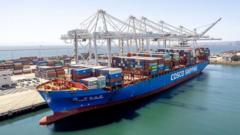The US is set to impose port fees on Chinese vessels, escalating tensions in global trade dynamics and potentially influencing shipping costs across various markets.
US Introduces New Port Fees for Chinese Ships Amid Trade Tensions

US Introduces New Port Fees for Chinese Ships Amid Trade Tensions
US Trade Representative aims to boost domestic shipbuilding and curb China's maritime dominance with hefty shipping fees.
The Trump administration has announced a new initiative to impose port fees on Chinese shipping vessels in an effort to bolster domestic shipbuilding and diminish China's stronghold over the industry. The US Trade Representative (USTR) revealed that these fees, which are expected to begin in 180 days, will gradually increase over three years and signal a more moderate approach compared to earlier proposals suggesting charges of up to $1.5 million (£1.1 million) per port visit.
The USTR has highlighted the perceived economic disadvantages posed by China's industry tactics, stating that "China has largely achieved its dominance goals, severely disadvantaging US companies, workers, and the US economy." Under the new structure, fees will be determined by various factors, including the weight of the cargo, container quantity, and the number of vehicles carried onboard by Chinese ship operators.
For bulk carriers, the charge will be $50 per ton initially, increasing by $30 annually for the next three years. Container vessels will see fees start at $18 per ton or $120 per container, similarly escalating in subsequent years. Additionally, non-US built ships transporting vehicles will incur a charge of $150 per vehicle. Each affected vessel will face these fees only once per voyage, limited to a maximum of five times each year.
However, certain exemptions will apply; for example, empty vessels arriving for cargo exports, inter-port shipments within the US, and vessels operating between US and Canadian ports on the Great Lakes will not be subjected to these fees. Also, a forthcoming phase targeting US shipbuilders will take effect in three years, focusing on strengthening the LNG shipping sector over the subsequent 22 years.
Industry experts warn that these port fees and ongoing tariff strategies may further stir disruptions in global trade. A recent report cited that cargo initially destined for the US is being redirected to European ports, raising concerns of increased prices for consumers within the US markets as supply chains adjust to these evolving conditions.
Since resuming his presidency, Trump has implemented tariffs on various imports from China that could reach as high as 245%. This has reportedly caused "significant buildups" of shipping vessels in the EU, resulting in congestion particularly noted in UK ports such as Felixstowe, as well as busy freight hubs in Rotterdam and Barcelona.
According to logistics professional Sanne Manders, current delays at these ports, compounded by strikes in key European locations, are indicative of broader implications stemming from the US tariffs. He notes that as businesses pivot towards sourcing new buyers in Europe, further port congestion may exacerbate supply chain issues, adding to costs that ultimately fall upon US consumers. While European shoppers may experience minimal effects from these changes, they stand to influence future market dynamics significantly as global supply chains evolve.


















